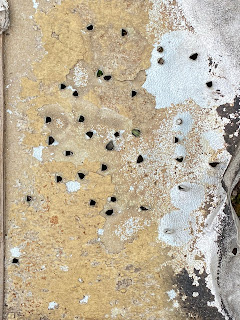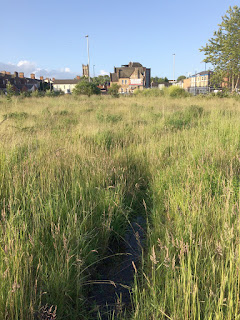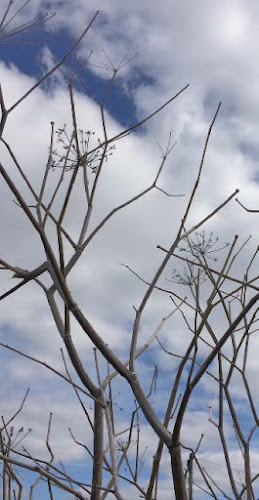AirSpace Gallery is pleased to announce COLLECTIVE TERRITORIES the first of our new programme's projects, we are working with UK artist Danny Treacy on a residency and exhibition. A 2-part project exploring memory of space and the significance of space. What makes a space special?
What makes a space personal?
What are the things that keep drawing us back to a space?
How do we see ourselves in a space? AndWhat do we feel there?
This is the first in a series of residency updates. More details about the residency can be found here - and to download the PDF of this report, click HERE
INTRODUCTION:
My practice is informed by process led research methods, within this I explore ideas of land use, shared experience and social invisibility.
The residency at AirSpace Gallery provides an opportunity to extend this via new research methods, which will then lead to greater informed outcomes.
The choice to extend research methods is informed by my intentions to carry out the residency in a manner that is sensitive to the relationship to spaces that is not based in the first instance by my own perspective or assumptions, but by the knowledge and relationship to places of the residents of Stoke-On-Trent, who I am collaborating with.
The ethos of the residency is to invite the sharing of information relating to particular spaces of personal importance, both contemporaneously and historically.
The sharing takes place remotely, using email as an initial starting point. To generate further responses from the participant’s, conversations, recollections, and digital imagery are given as examples, although the responses can and should take any form that the participant chooses.
RESEARCH & DEVELOPMENT BASED ON INITIAL RESPONSES:
There was a very good response from residents of Stoke once the residency call-out had taken place. The following pages are a compilation of the visual and text based responses from the initial sharing of relationships to locations by the participants.
REFLECTING ON RESPONSES (1):
I am being led through the places by the participants, this becomes a form of visual storytelling and sharing.
This sharing process is also, as I had hoped, a way to build a metal map of the various places.
What was unexpected is that it also gives me a feeling of familiarity with Stoke, as I am being led to areas of the town that I would never have planned on visiting if the residency had not had a collaborative element. This then becomes a form of ethnographic primary research.
REFLECTING ON RESPONSES (2):
This image became of particular significance; the focus of the image is the dried fennel stems and is indicative of the relationship to this place that a participant has, as a source of collecting these natural forms for both study and for consumption. These flowers are nurtured and tended, this place is labelled a ‘Brownfield’- “often (but not always) land that has been used for industrial and commercial purposes and is now derelict and possibly contaminated”.
This in itself is a fascinating relationship to a space that has already been officially classified as having no function. However what particularly drew my attention was the presence of cans in the image. The following page shows these in more detail.


The presence of cans on this site resonated with my practice. I am particularly interested in the way in which particular objects found in locations become ‘signifiers’ - indicative of the type of activities that take place there and also of the communities that function there at various times. This duality of usage is particularly relevant to both my practice and the residency. Following further conversations with the participant’s knowledge of this place, I discovered that this area is also where Uber drivers park up, collectively waiting for fares to come in. It also serves as a temporary dwelling place for homeless sleepers.
------------
REFLECTING ON RESPONSES (3):
The way in which litter becomes an indicator of a place’s functionality by diverse communities became very interesting, both as a mode of primary research and more importantly as a means to consider the ‘ethics of litter’ to inform research methods.
The following two participant’s images are particularly interesting in relation to the object’s status; they function as both litter and as artefact that indicates the area’s previous function.
Definitions of litter:
‘Litter is rubbish that is left lying around outside.’
‘A litter of things is a quantity of them that are lying around in a disorganized way.’
Definitions of artefact:
‘An artefact is an ornament, tool, or other object that is made by a human being, especially one that is historically or culturally interesting.’
Therefore, I’m interested in the times old litter can become charming or valuable, while contemporary litter is rarely given such association with ‘worth’.
- I’m interested in the duality of objects, how they can act as both litter and artefact. More importantly, I am interested in how these objects are indicative of territory.
This relationship to litter as territorial signifier is elaborated by Luke Turner, on the function of littering in a part of Epping Forest colloquially referred to as a ‘cruising ground’:
“As well as a signal to other men, litter acts as a
warning to everyone else, a territorial marker of a queer autonomous zone where heterosexuals might be advised not to tread. It also heavily genders the area, marking it out as a queer space, yes, but as an exclusively male one too.”
Turner L (2019) Out of the Woods. Weidenfield & Nicholson.
I find this particularly relevant in its connection to ethical approaches to littering as it is very easy to dismiss certain places due to the presence of litter. I believe litter is a valuable artefact that signifies a space’s functionality for diverse communities whose presence in the place is often actively dismissed or ignored.
These images are examples of the ways in which I am reflecting on different types of litter/artefacts in a place that I’m currently engaged with. There are aspects of representation arising from
these objects that the residency is allowing me to elaborate on as I understand the ways in which participant’s views of such items differs




















































